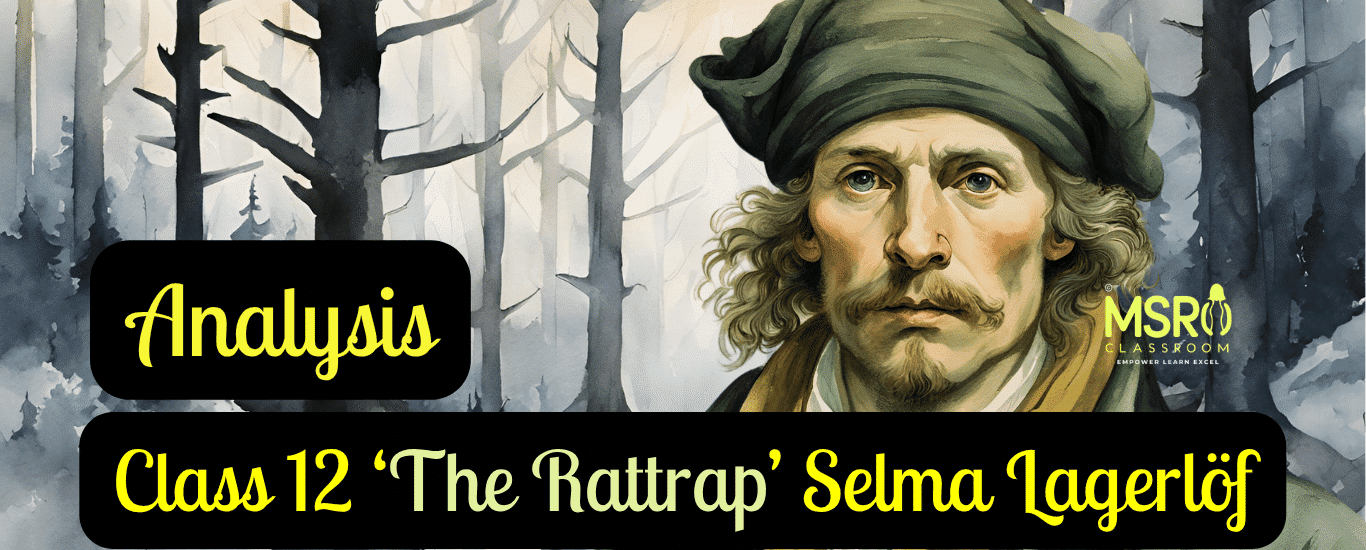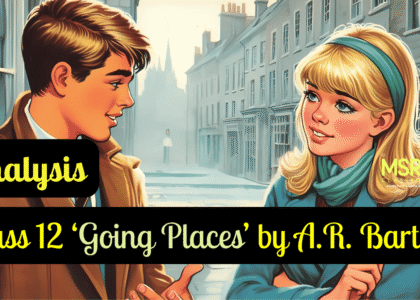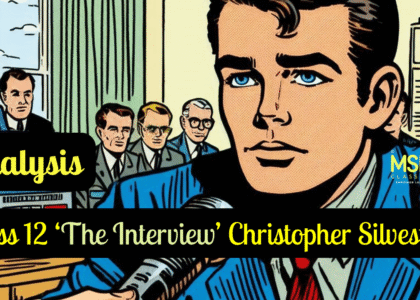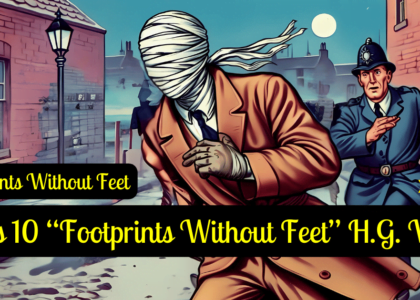“The Rattrap” by Selma Lagerlöf- Summary, Character Sketches, Theme, Textbook Question/ Answers.
Chapter 4- The Rattrap by Selma Lagerlöf:
Table of Contents:
Next on Flamingo: Chapter 5- “Indigo” by Louis Fischer, Chapter 6- Poets And Pancakes” by Asokamitan
Summary ‘The Rattrap’ by Selma Lagerlöf:
The story revolves around a vagabond who sells rattraps made of wire to make a living. He sees the world as a big rattrap, where people are lured by bait and then trapped. One evening, he seeks shelter at a kind older man’s cottage, steals money from him, and gets lost in a forest. Eventually, he finds himself at Ramsjo Ironworks, where he is mistaken for an old acquaintance by the Ironmaster.
The Ironmaster invites him to his home for Christmas despite the vagabond’s reluctance. His daughter, Edla, shows compassion for him and insists he stay. Throughout the day, the vagabond sleeps peacefully and is treated kindly. He is gifted a new suit by the Ironmaster and invited to return next Christmas.
After the family attends church on Christmas Day, they discover that the vagabond is a thief who had robbed a crofter. However, he leaves behind a rattrap with money and a letter to Edla. In the letter, he explains his actions and expresses gratitude for the kindness shown to him. The story ends with Edla feeling touched by the vagabond’s gesture.

Theme ‘The Rattrap’ by Selma Lagerlöf:
The story ‘The Rattrap’ by Selma Lagerlof explores themes of deception, redemption, and the trap of materialism that ensnares many individuals.
The Trap of Material Benefit:
The story’s central theme revolves around the idea that the world is akin to a rattrap, enticing individuals with material wealth and comfort only to ensnare them in its traps. The rattrap symbolises the allure of worldly possessions and desires that often lead people astray.
Throughout the narrative, characters such as the tramp and the ironmaster are depicted as being lured by the promise of riches and comfort, only to realise the emptiness and deceitfulness of these pursuits.
The tramp, in particular, falls victim to the temptation of stolen money, which ultimately leads him into a forest where he feels trapped and hopeless.
Sub-Theme:
Human Tendency to Redeem Oneself:
Amidst deception and materialism, a sub-theme explores the human tendency to seek redemption and atone for past wrongs. This theme is exemplified through the actions of the tramp, who, despite his initial dishonesty, ultimately chooses to return the stolen money and express gratitude to those who showed him kindness.
The character of the Ironmaster’s daughter, Edla Willmansson, also embodies this sub-theme through her compassionate and forgiving nature. Despite being deceived by the tramp, she chooses to extend grace and hospitality, believing in the possibility of his redemption.
To conclude, ‘The Rattrap’ delves into the complexities of human nature, illustrating how individuals can become trapped by the pursuit of material gain and deceit, yet also highlighting the potential for redemption and forgiveness amidst life’s traps and challenges.
Explanation for Auditory Learners: Chapter 4 ‘The Rattrap’:
Duration: 10 Minutes
Character Sketches ‘The Rattrap’ by Selma Lagerlöf:
1. The Protagonist (Rattrap Peddler):
The protagonist, the Rattrap Peddler, is a complex character whose journey forms the central narrative arc of “The Rattrap” by Selma Lagerlöf.
- Desperation and Poverty: The Rattrap Peddler is a vagabond living on the margins of society. He is destitute, surviving through begging, petty theft, and the sale of homemade rattraps. His impoverished circumstances contribute to his cynical outlook on life.
- Cynical Outlook: The protagonist views the world as a “big rattrap” designed to trap unsuspecting individuals with false promises of wealth and happiness. His experiences of hardship and betrayal have fostered a deep-seated distrust of society and its institutions.
- Loneliness and Alienation: The Rattrap Peddler leads a solitary existence, wandering from place to place. He lacks meaningful connections and struggles to accept and belong in a world that has largely rejected him. His isolation exacerbates his feelings of disillusionment and despair.
- Opportunism and Survival Instincts: Despite his moral ambiguity, the protagonist exhibits resourcefulness and adaptability in his quest for survival. He resorts to theft and deception to meet his basic needs, reflecting the harsh realities of those living on society’s fringes.
- Redemption and Transformation: Through his encounter with the crofter and Edla Willmansson, the protagonist experiences a gradual transformation. Their acts of kindness and compassion challenge his pessimistic worldview and awaken within him a glimmer of hope for redemption. He ultimately chooses to return the stolen money and embrace the possibility of a new beginning.
- Symbolism: The Rattrap Peddler serves as a symbolic representation of humanity’s capacity for both deception and redemption. His journey from cynicism to empathy highlights the transformative power of compassion and the inherent goodness that lies dormant within every individual.
The Rattrap Peddler’s character embodies themes of poverty, loneliness, redemption, and the search for meaning in a world fraught with deception and hardship. His evolution throughout the story highlights the enduring human quest for connection, understanding, and forgiveness.
2. Edla Willmansson:
Edla Willmansson is a crucial character in “The Rattrap,” her role is significant in shaping the narrative and exploring themes of kindness, compassion, and societal expectations.
- Compassionate and Empathetic: Edla stands out for her human nature. The protagonist’s plight moves her despite societal norms that typically encourage her to dismiss or fear him. Her empathy becomes a driving force in the story.
- Defies Social Expectations: Edla challenges societal expectations and norms by extending kindness to the vagabond. Instead of conforming to the prejudices against a wandering peddler, she sees beyond his appearance and offers him shelter and acceptance.
- Resilient and Assertive: Edla shows resilience in her decision to stand by her choice of helping the stranger, even when met with scepticism from her father and potential risks associated with the vagabond’s presence. She asserts her values of compassion and hospitality.
Role in the Story:
- Catalyst for Redemption: Edla’s kindness catalyses the vagabond’s redemption. Her genuine concern and acceptance create a transformative experience for him, challenging his cynical view of the world.
- Symbol of Hope: Edla symbolises hope and the potential for positive change in the face of societal prejudices. Her actions represent a counter-narrative to the prevailing mistrust and suspicion.
- Contrast to Father’s Views: Edla’s character highlights the contrast between generations and perspectives. While her father represents societal scepticism, Edla embodies a more compassionate and open-minded worldview.
Character Development:
- Edla undergoes a subtle but impactful transformation in the story. Her interactions with the vagabond challenge her initial perceptions, leading to a deeper understanding of humanity and the capacity for redemption.
Textbook Question/ Answers “The Rattrap”:
Think As You Read:
| Q1: From where did the peddler get the idea of the world being a rattrap? A1: The peddler got the idea of the world being a rattrap from his reflections and experiences as a vagabond. He saw the world as offering baits and traps to lure people into trouble, just like a rattrap offers bait to catch rats. Q2: Why was he amused by this idea? A2: He was amused by the idea because it provided him with a way to make sense of his own experiences and the hardships he faced. It gave him a perspective through which he could understand the world and his place in it, even if it was cynical. Q3: Did the peddler expect the kind of hospitality that he received from the crofter? A3: No, the peddler did not expect the kind of hospitality he received from the crofter. He was used to being met with sour faces and rejection, but the crofter welcomed him warmly, fed him, played cards, and shared his life story. This unexpected kindness surprised the peddler. Q4: Why was the crofter so talkative and friendly with the peddler? A4: The crofter was talkative and friendly with the peddler because he was lonely and welcomed the opportunity to have someone to talk to. His lack of family and companionship made him appreciate the company of the peddler despite the latter’s vagabond status. Q5: Why did he show the thirty kroner to the peddler? A5: The crofter showed the thirty kroner to the peddler as a gesture of trust and perhaps also to boast about his good fortune. He wanted to share his happiness and success with someone, even if it was a passing acquaintance like the peddler. Q6: Did the peddler respect the confidence reposed in him by the crofter? A6: No, the peddler did not respect the trust reposed in him by the crofter. He took advantage of the crofter’s kindness and stole the thirty kroner from him when he returned to the cottage after initially leaving. This action demonstrated the peddler’s lack of integrity and gratitude. Q7: What made the peddler think that he had indeed fallen into a rattrap? A7: The peddler thought he had fallen into a rattrap because he found himself trapped in the forest, unable to find his way out despite his efforts. This situation reminded him of his philosophy that the world is like a rattrap, luring people with promises of riches and joys only to trap them in trouble and despair. Q8: Why did the Ironmaster speak kindly to the peddler and invite him home? A8: The ironmaster spoke kindly to the peddler and invited him home initially because he mistook him for an old acquaintance named Nils Olof. The ironmaster remembered him fondly and wanted to offer him hospitality, believing him in need. Q9: Why did the peddler decline the invitation? A9: The peddler declined the invitation because he feared being recognised as an impostor. He had stolen thirty kronor from the old crofter, and he worried that if he went to the ironmaster’s home, he might be discovered and arrested. He preferred to stay in the forge, where he felt he could remain inconspicuous. Q10: What made the peddler accept Edla Willmansson’s invitation? A10: The peddler accepted Edla Willmansson’s invitation because she showed him kindness and compassion. Despite his initial reluctance, her genuine concern for his well-being and her invitation to spend Christmas with them touched him. Q11: What doubts did Edla have about the peddler? A11: Edla had concerns about the peddler’s background and intentions. She suspected he might have stolen something or escaped from jail, as indicated by her observation that “Either he has stolen something or else he has escaped from jail” when she saw his frightened reaction upon being awakened. Q12: When did the ironmaster realise his mistake? A12: The ironmaster realised his mistake when he saw the peddler in broad daylight, well-groomed and dressed in his clothes. He recognised that he had been deceived by the stranger’s appearance in the dim light of the forge and acknowledged that it was not entirely honest of the peddler to pretend to be someone he was not. Q13: What did the peddler say in his defence when it was clear that he was not the person the ironmaster had thought he was? A13: When it became clear that he was not the person the ironmaster thought he was, the peddler defended himself by acknowledging that he never pretended to be anything but a poor trader. He admitted that he had begged to stay in the forge and claimed that no harm had been done. He also mentioned that he could put on his rags again and leave if necessary. Q14: Why did Edla still entertain the peddler even after she knew the truth about him? A14: Edla still entertained the peddler even after she knew the truth about him because she felt empathy and compassion for him. She believed everyone deserved kindness and a chance to feel welcomed and at peace, especially during Christmas. Despite his deception, she focused on his humanity and extended forgiveness and hospitality to him. Q15: Why was Edla happy to see the gift left by the peddler? A15: Edla was pleased to see the gift left by the peddler because it contained three ten kronor notes and a letter. The peddler, who referred to himself as Captain von Stahle in the letter, expressed gratitude for Edla’s kindness throughout the day. He returned the money he had taken from the older man’s pouch, indicating that he did not want Edla embarrassed by unwittingly harbouring stolen goods. The gift and the letter showed that despite his initial deception, the peddler had a sense of honour and gratitude towards Edla, which touched her deeply. Q16: Why did the peddler sign himself as Captain von Stahle? A16: The peddler signed himself as Captain von Stahle as part of his ruse to gain sympathy and hospitality. He likely chose the title of captain to create an impression of respectability and dignity, which he hoped would lead to a more favourable reception by the ironmaster and his daughter. This persona allowed him to temporarily escape his identity as a rattrap peddler and present himself in a more respectable light, facilitating his entry into the household and his eventual redemption through Edla’s kindness. |
Understanding The Text:
Q1: How does the peddler interpret the acts of kindness and hospitality shown by the crofter, the ironmaster and his daughter?
A1: The peddler interprets the acts of kindness and hospitality directed by the crofter, the ironmaster, and his daughter, initially with suspicion and opportunism.
He sees the crofter’s generosity as an opportunity to steal, the ironmaster’s invitation as a chance to escape trouble, and the daughter’s kindness as a gesture of pity or charity.
However, as the story progresses, especially after his encounter with the daughter, he begins to see genuine goodness and compassion in their actions, eventually leading to a change of heart.
Q2: What are the instances in the story that show that the character of the ironmaster is different from that of his daughter in many ways?
A2: In Selma Lagerlöf’s “The Rattrap,” the differences between the Ironmaster and his daughter’s characters include their contrasting reactions to the peddler and their attitudes towards social status.
- The Ironmaster treats the peddler with suspicion and quickly judges him based on his appearance and social standing. In contrast, his daughter displays empathy and kindness towards the peddler, seeing beyond his outward appearance to his humanity.
- The Ironmaster’s focus is primarily on social status and appearances. He is concerned about how the peddler’s presence reflects their household and reputation. Conversely, his daughter prioritises compassion and hospitality, regardless of the peddler’s background or circumstances.
- While the ironmaster hesitates to extend hospitality to the peddler and is more concerned about potential theft or trouble, his daughter insists on offering kindness and support without judgment or reservation.
These instances illustrate the fundamental differences in values and priorities between the ironmaster, bound by societal expectations and status, and his daughter, who values compassion and human connection above appearances and social norms.
Q3: The story has many instances of unexpected reactions from the characters to others’ behaviour. Pick out instances of these surprises.
A3: Several cases of unexpected reactions from characters to others’ behaviour occur in Selma Lagerlöf’s “The Rattrap”:
- The Crofter’s Hospitality: The peddler is surprised by the crofter’s unexpected generosity and kindness when he offers him shelter, food, and companionship for the night without any apparent ulterior motive. This contrasts with the peddler’s usual experiences of rejection and suspicion from others.
- The Ironmaster’s Invitation: The Ironmaster’s decision to invite the peddler to his home for Christmas Eve initially surprises both the peddler and the reader, given the Ironmaster’s initial suspicion of the stranger. This unexpected invitation challenges the peddler’s cynical view of human nature and sets the stage for further surprises.
- The Daughter’s Compassion: The daughter’s genuine compassion and empathy towards the peddler, despite his rough appearance and dubious background, surprise her and her father. Her insistence on offering hospitality and kindness to a stranger challenges societal norms and expectations, demonstrating her capacity for understanding and acceptance.
- The Peddler’s Act of Redemption: The peddler’s unexpected act of returning the stolen money and leaving a gift for the daughter surprises both the ironmaster and his daughter, demonstrating a transformation in his character. This unexpected gesture highlights the peddler’s capacity for redemption and gratitude, challenging assumptions about his motives and character.
Q4: What made the peddler finally change his ways?
A4: The peddler finally changes his ways by experiencing genuine kindness and compassion from others, particularly the ironmaster’s daughter. Despite his past actions and appearance, her empathy and generosity towards him make him reconsider his cynical view of the world and inspire him to act with honesty and gratitude.
Q5: How does the metaphor of the rattrap serve to highlight the human predicament?
A5: The metaphor of the rattrap highlights the human predicament by illustrating how people can become ensnared by the temptations and traps of life. Just as the rattrap baits rats with the promise of food, the world tempts people with material comforts and desires.
The peddler sees himself and others as rats caught in this metaphorical rattrap, constantly chasing after illusory rewards and risking getting caught in the traps of greed and dishonesty.
Q6: The peddler comes out as a person with a subtle sense of humour. How does this serve in lightening the seriousness of the theme of the story and also endear him to us?
A6: The peddler’s subtle sense of humour highlights the story’s theme’s seriousness by adding fun and ironic moments. His wry observations about the world being a rattrap and his acknowledgement of his predicament inject a certain playfulness into the narrative.
This humour endears him to the readers and makes his transformation more relatable and human. It also helps to balance the story’s darker aspects with moments of lightness and hope.
Talking About The Text:
Discuss:
1. The reader’s sympathy is with the peddler right from the
beginning of the story. Why is this so? Is the sympathy justified?
The reader’s sympathy is likely with the peddler from the story’s start because of the portrayal of his plight. The peddler is depicted as an oppressed and impoverished individual who resorts to petty thievery to survive.
His reflective thoughts about the world being akin to a rattrap, where individuals are lured in by false promises and then ensnared, evoke empathy. Also, his interactions with the old man and later with Edla Willmansson showcase moments of kindness and understanding amidst his struggles.
While sympathy for the peddler is understandable given his circumstances, whether it is justified ultimately depends on individual interpretations of morality and empathy.
2. The story also focuses on human loneliness and the need to bond with others.
The story delves into themes of human loneliness and the need for connection. The peddler’s isolation and transient lifestyle highlight the loneliness experienced by individuals on the fringes of society.
However, his brief interactions with others, particularly with Edla Willmansson, illustrate the potential for human connection and compassion to alleviate loneliness.
Through her kindness and hospitality, Edla offers the peddler a sense of belonging and acceptance, even temporarily.
3. Have you known/heard of an episode where a good deed or an act of kindness has changed a person’s view of the world?
Yes, there are countless real-life instances where acts of kindness or good deeds have profoundly impacted individuals’ perspectives on the world. Small gestures of compassion and understanding can have ripple effects, fostering hope, gratitude, and trust.
Whether it’s a stranger offering assistance during a time of need or a friend providing emotional support during challenging times, such acts often leave lasting impressions and reshape one’s outlook on humanity and the world.
4. The story is both entertaining and philosophical.
Indeed, “The Rattrap” by Selma Lagerlof is entertaining and philosophical.
Entertaining:
The story is structured like a traditional fairy tale, with elements of adventure, suspense, and unexpected twists. The peddler’s journey, from his initial struggles to encounters with different characters, creates a narrative that captivates the reader’s interest.
Lagerlof’s vivid descriptions of the setting, characters, and events contribute to the story’s entertainment value, drawing readers into the world of the peddler and his experiences.
The narrative unfolds in a manner that keeps readers engaged, with moments of tension, humour, and intrigue throughout.
Philosophical:
Beneath the surface of its entertaining plot, “The Rattrap” explores deeper philosophical themes and ideas. Through the peddler’s musings about the world being a rattrap, Lagerlof introduces philosophical questions about human nature, the pursuit of happiness, and the concept of traps and illusions in life.
The story prompts readers to reflect on empathy, compassion, redemption, and the transformative power of kindness. The peddler’s journey serves as a metaphor for the human condition, highlighting the struggles, temptations, and opportunities for growth that individuals encounter on their paths through life.
Ultimately, “The Rattrap” invites readers to ponder existential questions and consider the complexities of human existence.
Working with words:
1. The man selling rattraps is referred to by many terms such as “peddler, stranger,” etc. Pick out all such references to him. What does each of these labels indicate of the context or the attitude of the people around him?
- “Rattrap peddler” and “stranger” indicate his occupation and unfamiliarity.
- “Vagabond,” “tramp,” “ragamuffin,” and “fellow” suggest his perceived social status and appearance.
- “Poor trader” reflects his financial situation.
- “Thief” is an accusation based on suspicion.
- “Captain von Stahle” is a title he gave himself, indicating his desire to elevate his status, albeit falsely, in the eyes of others.
2. You came across the words, plod, trudge, and stagger in the story. These words indicate movement accompanied by weariness. Find five other such words with a similar meaning.
Words indicating movement accompanied by weariness:
- Shuffle
- Limp
- Drag
- Lurch
- Totter
- Stumbled






